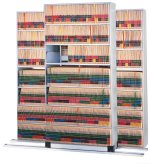Not sure if this is the right forum, but I'm just curious how other print shops file their projects once complete. I feel like the system we are using is so antiquated and time wasting. It's actually improved lately with generating job tickets via fillable form on Acrobat. We had a few boxes of these clear plastic job bags (9x12) that we're now using in the same fashion as previously (see below). We just started filing them now that we have quite a few jobs complete, but I'm thinking it's counterproductive to file the job INCLUDING the plastic job bag! I mean, we're going to run out of them at some point!! THEN what?? I'm thinking if they insist on continuing with the strictly numerical system, we'll have to use manila folders or something to file them so that the samples etc. are contained with the associated job ticket.
We USED to photocopy the previous job ticket (for repeat orders or similar orders just for reference), Then HAND WRITE a new job ticket printed on a 9x12 envelope. Basically COPYING everything on that previous ticket to a new ticket. Every shred of communication is printed and added to the job ticket (the envelope), including previous samples for color reference and stock reference, and once the job is complete, it gets filed in NUMERICAL job ticket order. We have literally 14 4 drawer filing cabinets FILLED with these envelopes and their contents, as well as a few more years back of job tickets in envelope boxes. I'd estimate that count at about 30-50 boxes. It's INSANE if you ask me. My art files are alpha by company, then job ticket numbered folders in that folder, then all the art files and components in sub folders. The entire filing system of job tickets is strictly numerical. God forbid if someone mis files something. You'll NEVER find it. Oh yeah, it's happened... Anyway, just curious how you all file your jobs once complete. Maybe I can make a new suggestion that'll fly.
What I did at a place I worked before was a vertical filing system like doctors offices use, and get the lettered color coded labels and use the first 3 letters of the company name for that file, then use a manila folder to contain any pertinent info that we'd need to know for future orders, as well as a sample of the job. It was all ALPHA and worked SO well. If there was a repeat order, then just generate a job ticket by cloning the previous one with appropriate adjustments for date, etc, and then pull a sample from the previous job for color matching and such. I suggested that and it was shot down immediately and was told not to bring it up again. LOL
We USED to photocopy the previous job ticket (for repeat orders or similar orders just for reference), Then HAND WRITE a new job ticket printed on a 9x12 envelope. Basically COPYING everything on that previous ticket to a new ticket. Every shred of communication is printed and added to the job ticket (the envelope), including previous samples for color reference and stock reference, and once the job is complete, it gets filed in NUMERICAL job ticket order. We have literally 14 4 drawer filing cabinets FILLED with these envelopes and their contents, as well as a few more years back of job tickets in envelope boxes. I'd estimate that count at about 30-50 boxes. It's INSANE if you ask me. My art files are alpha by company, then job ticket numbered folders in that folder, then all the art files and components in sub folders. The entire filing system of job tickets is strictly numerical. God forbid if someone mis files something. You'll NEVER find it. Oh yeah, it's happened... Anyway, just curious how you all file your jobs once complete. Maybe I can make a new suggestion that'll fly.
What I did at a place I worked before was a vertical filing system like doctors offices use, and get the lettered color coded labels and use the first 3 letters of the company name for that file, then use a manila folder to contain any pertinent info that we'd need to know for future orders, as well as a sample of the job. It was all ALPHA and worked SO well. If there was a repeat order, then just generate a job ticket by cloning the previous one with appropriate adjustments for date, etc, and then pull a sample from the previous job for color matching and such. I suggested that and it was shot down immediately and was told not to bring it up again. LOL










